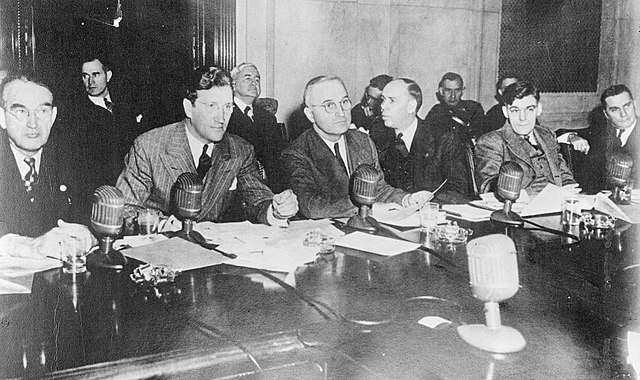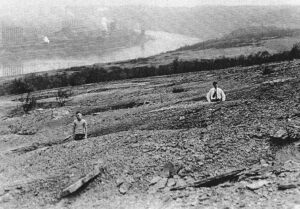
Truman War Investigating Committee, 1942, uncovers evidence of oil industry treason and collusion with Nazis.
1940 — US Congress passes Bald Eagle Preservation Act which prohibits selling, killing, or possessing the species.
1940 — Walt Disney film Bambi changes perceptions of deer hunting and encourages a more humane view of nature.
1940 — Aug. 6 — Russian geneticist Nikolai Vavilov is arrested for opposing the politically bent science of Trofim Lysenko. Vavliov’s work lives on at the N.I. Vavilov Institute of Plant Industry in St. Petersburg, Russia.
1941.
1941 — St. Louis adopts first strict smoke control ordinance in U.S. Meanwhile, St. Louis Post Dispatch wins first Pulitzer Prize for environmental reporting. The Pulitzer committee cites the Dispatch “For its successful campaign against the smoke nuisance.”
1941 — “Action Club” formed to combat pollution from paper mills near Augusta, Maine. (Richard W. Judd, The Coming of the Clean Waters Acts in Maine, 1941-1961, Environmental History Review Vol. 14, No. 3 (Autumn, 1990), pp. 50-73).
1941 — Between 25,000 and 60,000 rooftop solar water heaters are being used, mostly in Florida and California. In Miami 80 percent of new homes are built with solar hot water. War materials needs prevent industry expansion. (Butti & Perlin, 1980)
1941, Oct. 10 — Nigerian Environmental leader Ken Sara-Wiwa born.
1941 — Aqueducts begin diverting water from streams feeding Mono Lake into the Los Angeles water supply, dropping the shoreline by 45 feet in height in 1982. It has recovered 11 feet.
1941– Rachel Carson writes Under the Sea-Wind, Oxford University Press, a naturalist’s picture of ocean life. Carson would become famous in 1952 for The Sea Around Us and in 1962 for Silent Spring, which warned against overuse of pesticides.
1942
1942– Sen. Harry S. Truman’s war investigating committee exposes a treasonous pre-war relationship between American companies Ethyl, Standard Oil (Exxon), General Motors and DuPont on the one hand and the German chemical company I.G. Farben on the other. Internal company memos described the relationship as a “full marriage” which was “designed to outlast the war” no matter which side won. Ethyl had given leaded gasoline production technology to I.G. in return for patents on synthetic rubber to G.M. and DuPont. The U.S. companies did little research but vigorously protected the German synthetic rubber patents. When the war opened, supplies of rubber (a critical strategic material) were cut off by the Japanese and synthetic rubber from oil had been blocked. At the time, British intelligence calls Standard Oil a “hostile and dangerous element of the enemy.” (Stephenson, 1976, Borkin, 1978).
1942 — Controversy emerges over a hydroelectric dam that would inundate Cook Forest, a state park protecting some of the last of Pennsylvania’s uncut native forests. The dam is never built.
1942– Critical shortage of rubber leads to development of new crops such as guayule and new chemical approaches such as corn ethanol to butadiene. By 1944, two thirds of the Army and Air Force is rolling on tires made from Midwestern corn. (Bernton, 1982)
1943
1943 — Audubon nature center opens in Greenwich, Ct. and becomes a model for other nature centers.
1944
1944 — Cleveland, Ohio natural gas explosion

1944 — Soil Conservation Society formed by Hugh Bennett.
1944 — War Production Board reports that industrial accidents killed 37,600 workers and injured 210,000 permanently and 4.5 million temporarily between Dec. 7, 1941 and Jan. 1, 1944. Comparable figures for soldiers were 30,100 killed and 75,000 wounded. (Corn, 1992).
1945
1945 — Corps of Engineers abandons Potomac River dam after a storm of controversy and protests from Izaak Walton League, National Parks Association, garden clubs and others.
July 16 — World’s first atomic weapon explosion, the Trinity test takes place at Alamogordo, New Mexico. Infant mortality goes up sharply in the area downwind of the tests.
Aug. 6 and 9 — US drops atomic bombs on the Japanese cities of Hiroshima and Nagasaki.
Sept. 28 . – U.S. President Harry Truman issues Proclamation on the Continental Shelf clearing the way for offshore oil drilling.
1946
1946 — Nuclear reactor accident kills scientist at Los Alamos National Labs, NM.
1946 — Oil executives concerned about pollution form a “Smoke and Fumes Committee” at the American Petroleum Institute.
1946-48 — Bikini and Eniwetok atolls nuclear tests South Pacific, Marshall Islands. These tests were far smaller than the hydrogen bomb tests of 1954.
1946 — US Bureau of Land Management established.
1946 — International Whaling Commission formed in response to rapid decline of whale populations worldwide. With continued decline, in 1986, the IWC imposed a total ban on commercial whaling. Countries such as Japan and Norway have not honored the IWC ban.
1946 — Gifford Pinchot, former governor of Pennsylvania, former Forest Service chief, dies in New York.
1947
1947 — Los Angeles Air Pollution Control District is the first air pollution control bureau in the nation. A 50-year anniversary history gives the story. c
March 28, 1947 — UN calls for a conference on conservation of natural resources to be held in 1949.

The SS Wilson B. Keene, destroyed by explosions in the Texas City Disaster 1947.
April 16, 1947 — Texas City disaster is the deadliest industrial accident in US history, killing at least 581 people
1947 — At request of Mohandas Gandhi, Jawaharal Nehru writes into the Constitution of India — Article 51-A[g] that “It shall be the fundamental duty of every citizen of India to protect and improve the Natural Environment including forests, lakes, rivers and wildlife, and to have compassion for all living creatures.”
1947 — Defenders of Wildlife founded.
1947 — Dec. 6 — Everglades National Park established. Marjory Stoneman Douglas, author of Everglades, River of Grass, is honored by President Harry Truman at the park’s opening.
1947 — French farmers living south of Paris protest constuction of a prototype reactor by the French Atomic Energy Commission. (Weart, p. 281).
1948 — Declaration of Geneva — World Medical Association issues a modern re-statement of the Hippocratic Oath, noting in part the duty of physicians to serve the humanitarian goals of medicine.
1948
1948 — US files antitrust suit against Du Pont to break up “largest single concentration of power in the United States.” Main target is Du Pont’s partial but more or less controlling ownership of General Motors.
1948 — David Sheldrick founds Tsavo National Park in Kenya. His young wife Daphne began rehabilitating wildlife, and eventually became the first person to successfully rehabilitate orphaned elephants. Daphne Sheldrick was acquainted with another young rehabilitator, Martine Colette, the daughter of a Belgian diplomat stationed in Kenya. Colette later founded the Wildlife Waystation sanctuary near Los Angeles. David Sheldrick died in 1976, six months after a forced relocation to Nairobi National Park to accommodate the interests of ivory traffickers. Daphne Sheldrick persevered, however, eventually winning a national ban on sport hunting and the opposition of the Kenyan government to resumption of international trade in ivory. (M. Clifton, 2007)
1948 — Federal Water Pollution Control Act; beginning of active House and Senate Public Works Committee interest in water pollution.
Sept. 7 – 20, 1948 — Inter-American Conference on Conservation of Renewable Natural Resources, held in Denver.
Oct. 5, 1948 — International Union for the Conservation of Nature is established in the French town of Fontainebleau. “As the first global environmental union, it brought together governments and civil society organizations … to encourage international cooperation and provide scientific knowledge and tools to guide conservation action.”
Oct. 31, 1948 — Donora, Pennsylvania air pollution disaster. Twenty twi people die, 600 are hospitalized and thousands more are made sick as smoke from steel and zinc works is trapped in a four-day inversion, a weather phenomena where pollution is trapped beneath a cold layer of air. Oxygen is so depleted on the night of Oct. 30 that cars cannot run, and the smoke is so thick that doctors and nurses go from house to house, giving people oxygen and shots of adrenaline. It’s one of the first nationally publicized environmental disasters and leads to new air pollution studies and laws. See AJPH “Donora Revisited,” and “Donora, an environmental disaster of the 20th century”.
Environmental books of 1948:
- Henry Fairfield Osborn Jr. – Our Plundered Planet
- William Vogt – Road to Survival — Argued that trends in population growth were destroying the environment for future generations.
- Aldo Leopold – A Sand County Almanac.
- “By and large, our present problem is one of attitudes and implements. We are remodeling the Alhambra (river) with a steam-shovel, and we are proud of our yardage. We shall hardly relinquish the shovel, which after all has many good points, but we are in need of gentler and more objective criteria for its successful use.”
1949
1949 — Canadian complaints about Detroit pollution launch Public Health Service study of Detroit-Windsor area under 1909 boundary treaty.
1949 — First US conference on air pollution sponsored by Public Health Service.
1949, Aug. 17 — United Nations Scientific Conference on Conservation and the Utilization of Natural Resources brings 700 scientists together. The conference focuses on forest conservation and critical resource shortages.
1949 — Mira Behn (Madeleine Slade), an English confidant and servant of Mahatma Ghandi, writes: “The tragedy today is that educated and moneyed classes are altogether out of touch with the vital fundamentals of existence — our Mother Earth, and the animal and vegetable population which she sustains. This world of Nature’s planning is ruthlessly plundered, despoiled and disorganized by man whenever he gets the chance. By his science and machinery he may get huge returns for a time, but ultimately will come desolation. We have got to study Nature’s balance and develop our lives within her laws if we are to survive as a physically healthy and morally decent species.” (quoted in Guha, 2000).
1949 — Izaak Walton League writes “Crisis Spots in Conservation,” identifying specific water projects that present environmental problems.

